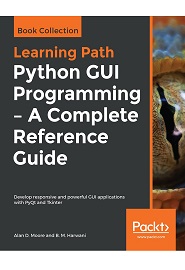
English | 2019 | ISBN: 978-1838988470 | 746 Pages | PDF, EPUB | 22 MB
Explore Python’s GUI frameworks and create visually stunning and feature-rich applications
A responsive graphical user interface (GUI) helps you interact with your application, improves user experience, and enhances the efficiency of your applications. With Python, you’ll have access to elaborate GUI frameworks that you can use to build interactive GUIs that stand apart from the rest.
This Learning Path begins by introducing you to Tkinter and PyQt, before guiding you through the application development process. As you expand your GUI by adding more widgets, you’ll work with networks, databases, and graphical libraries that enhance its functionality. You’ll also learn how to connect to external databases and network resources, test your code, and maximize performance using asynchronous programming. In later chapters, you’ll understand how to use the cross-platform features of Tkinter and Qt5 to maintain compatibility across platforms. You’ll be able to mimic the platform-native look and feel, and build executables for deployment across popular computing platforms.
By the end of this Learning Path, you’ll have the skills and confidence to design and build high-end GUI applications that can solve real-world problems.
This Learning Path includes content from the following Packt products:
- Python GUI Programming with Tkinter by Alan D. Moore
- Qt5 Python GUI Programming Cookbook by B. M. Harwani
What you will learn
- Visualize graphs in real time with Tkinter’s animation capabilities
- Use PostgreSQL authentication to ensure data security for your application
- Write unit tests to avoid regression when updating code
- Handle different signals generated on mouse clicks using QSpinBox and sliders
- Employ network concepts, internet browsing, and Google Maps in UI
- Use graphics rendering to implement animations in your GUI
Resolve the captcha to access the links!